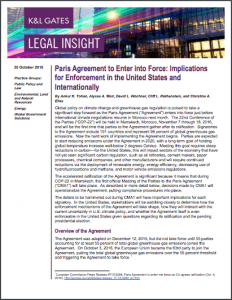Full Title: Paris Agreement to Enter into Force: Implications for Enforcement in the United States and Internationally
Author(s): Ankur K. Tohan, Alyssa A. Moir, David L. Wochner, Cliff L. Rothenstein, and Christina A.
Publisher(s): K&L Gates
Publication Date: October 1, 2016
Full Text: Download Resource
Description (excerpt):
Global policy on climate change and greenhouse gas regulation is poised to take a significant step forward as the Paris Agreement (“Agreement”) enters into force just before international climate negotiations resume in Morocco next month. The 22nd Conference of the Parties (“COP-22”) will be held in Marrakech, Morocco, November 7 through 18, 2016, and will be the first time that parties to the Agreement gather after its ratification. Signatories to the Agreement include 191 countries and represent 95 percent of global greenhouse gas emissions. Now the hard work of implementing the Agreement begins. Parties are expected to start reducing emissions under the Agreement in 2020, with a long-term goal of holding global temperature increase well-below 2 degrees Celsius. Meeting this goal requires steep reductions in carbon—for the United States, this will impact sectors of the economy that have not yet seen significant carbon regulation, such as oil refineries, cement makers, paper processers, chemical companies, and other manufacturers and will require continued reductions via the deployment of renewable energy, energy efficiency, decreasing use of hydrofluorocarbons and methane, and motor vehicle emissions regulations.
The accelerated ratification of the Agreement is significant because it means that during COP-22 in Marrakech, the first official Meeting of the Parties to the Paris Agreement (“CMA1”) will take place. As described in more detail below, decisions made by CMA1 will operationalize the Agreement, putting compliance procedures into place.
The details to be hammered out during CMA1 will have important implications for each signatory. In the United States, stakeholders will be watching closely to determine how the enforcement mechanisms of the Agreement will take shape, how they will interact with the current uncertainty in U.S. climate policy, and whether the Agreement itself is even enforceable in the United States given questions regarding its ratification and the pending presidential election.
